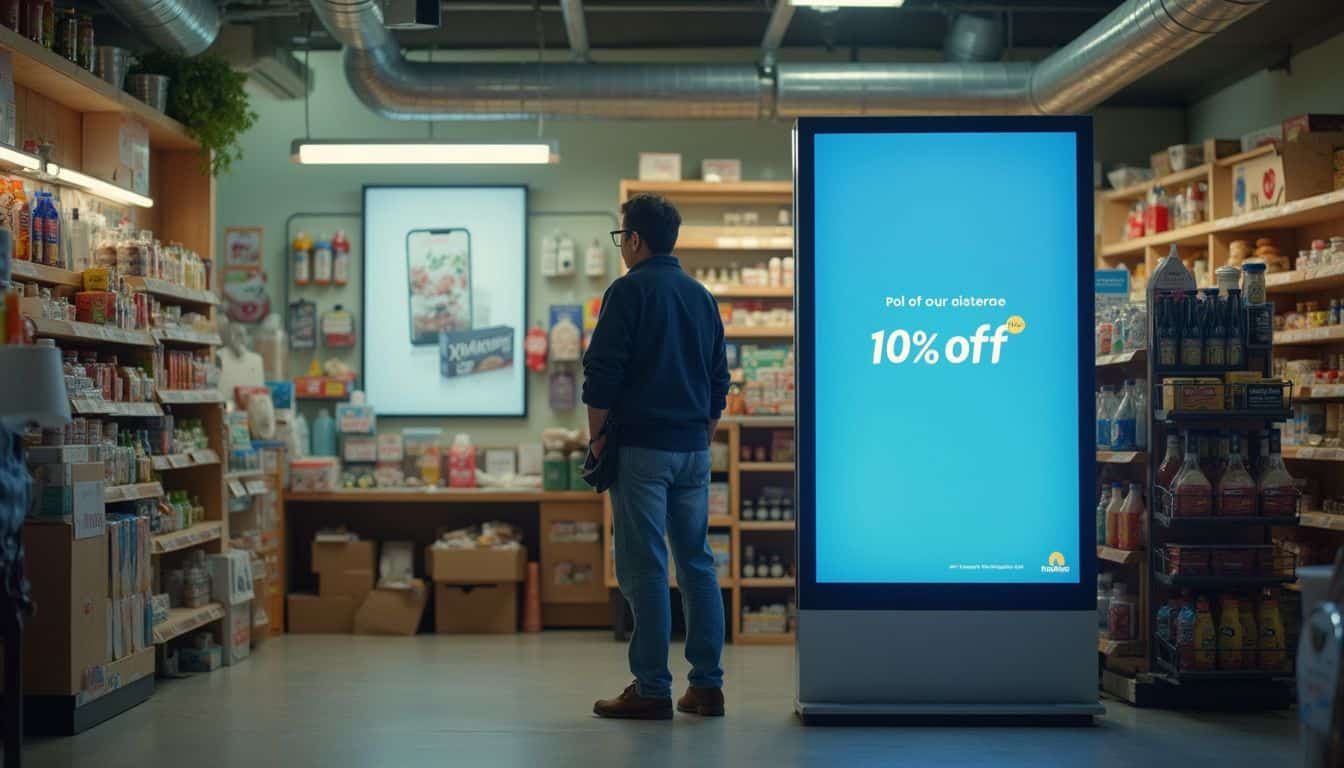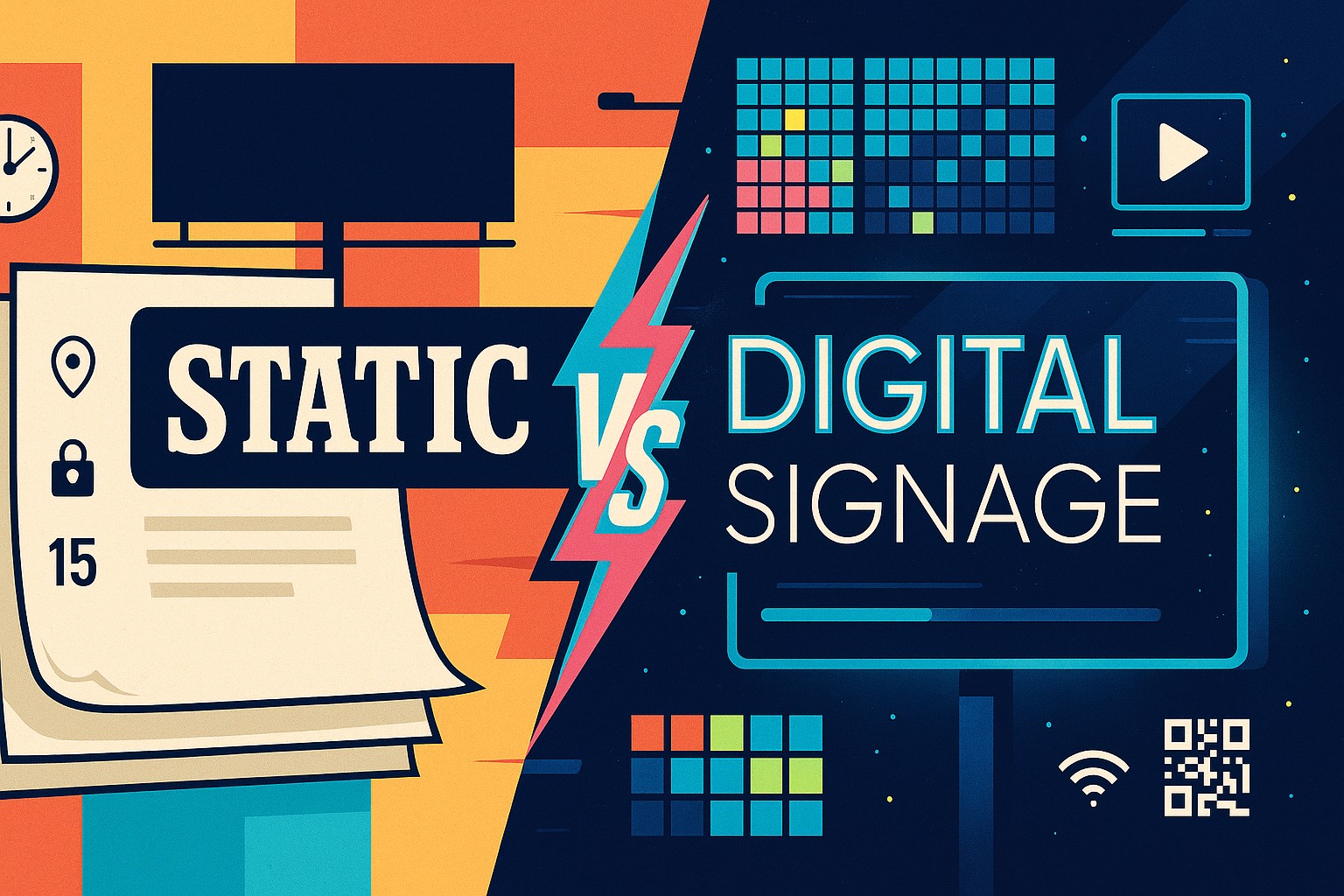Business owners face a tough choice between static and digital signs. Digital displays attract 400% more views than traditional posters. This guide explains five major differences between static vs digital signage to help you decide what works best.
You’ll discover which option saves money and engages customers better.
Key Takeaways
Digital signs capture 400% more views than static displays. They increase brand awareness by 47.7% and help stores boost sales by 29.5% through interactive features and instant content changes.
Static signs cost $50-$100 for a standard poster. Digital displays range from $500-$2,000 upfront but save businesses up to $350,000 over five years by eliminating reprinting costs.
Digital displays reduce wait times by 35% through engaging content. They lead to 30% more upsells in retail stores, with 68% of customers buying products they see on screens.
By 2025, AI-powered digital signage will offer automated content management and augmented reality experiences. Energy-efficient displays will reduce carbon footprints and qualify businesses for tax benefits.
Static signs excel in durability without needing power or internet. They work great for permanent information. Digital signs offer better flexibility for time-sensitive promotions and emergency messages.
Table of Contents
Overview of Static Signage

Static signs have been the backbone of business advertising for generations. These traditional displays include printed banners, posters, and classic neon signs that create instant visual impact. Many retail stores still rely on their timeless appeal and physical presence.
What is static signage and where is it commonly used?
 Static signage displays are fixed advertising materials that don’t change electronically. Think of billboards, posters, and banners you see every day. These permanent fixtures help businesses share basic information with customers.
Static signage displays are fixed advertising materials that don’t change electronically. Think of billboards, posters, and banners you see every day. These permanent fixtures help businesses share basic information with customers.
Traditional signs come in many forms. Vinyl banners, metal signs, and wooden boards are common choices. They work perfectly for showing store hours, directions, and other details that rarely change.
Traditional signage remains a cornerstone of business communication, offering reliability and consistency in message delivery.
Business owners choose static signs for their toughness and simple messaging. You’ll find them at storefronts, office buildings, and public spaces everywhere. The materials vary from plastic and metal to glass and natural fibers.
Each material brings unique benefits to different settings. Floor graphics guide foot traffic. Window decals catch the eye. Wall murals tell brand stories. These creative displays help businesses build their identity without complex technology.
What are the benefits of using static signage?

Static signs offer several cost-effective advantages for businesses. Production and installation costs stay low. This makes them a smart one-time investment for permanent displays. Many businesses appreciate how static signs withstand harsh weather, perfect for outdoor advertising.
The durable materials in static signs ensure long-term reliability. They don’t need constant maintenance or repairs like digital options might.
Static signs excel in security and dependability. They work without software or internet connections. This makes them immune to cyber-attacks and system crashes. Their flexible placement helps maximize visibility in busy areas.
These displays deliver consistent messages around the clock. Power outages won’t affect them. Technical glitches can’t shut them down. Static signs just keep working, day after day.
The next section explores some drawbacks that come with static signage.
What are the limitations of static signage?

Static signs have clear drawbacks that limit their value for modern businesses. Physical signs need manual updates through reprinting every time content changes. This makes frequent updates expensive and slow.
The fixed nature of these displays prevents businesses from showing videos or animations. Interactive content that grabs attention simply isn’t possible with static signs.
Traditional signs can’t track viewer engagement or collect customer data. Business owners have no way to measure how well their messages work. They can’t adjust content based on what customers actually respond to.
The limited space on static displays creates tough choices. Companies must either show less information or cram too much text into small areas. Both options hurt effectiveness.
In today’s world of bright screens and digital content, basic signs often disappear into the background. They lose their marketing power and brand visibility when competing with more dynamic options.
Overview of Digital Signage

Digital sign systems combine bright LED screens with multimedia content and instant updates. These modern displays show targeted ads, emergency alerts, and social media feeds through cloud-based software. Businesses can change their messages instantly from anywhere.
What defines digital signage and what are its main features?

Digital signage uses electronic displays like LED screens, LCD monitors, and projections to show content. These smart displays mix videos, animations, and live updates that capture attention instantly. Special software lets users control and schedule content from one central location.
Modern digital signage acts as your 24/7 virtual sales team, delivering targeted messages right when your audience needs them.
The main features include interactive touchscreens, QR codes, and motion sensors. These elements respond to viewer actions and create engaging experiences. Businesses can update messages instantly across multiple locations at once.
This technology fits perfectly in retail stores, offices, restaurants, and transport hubs. The displays also offer green benefits with energy-efficient displays that reduce paper waste. Smart management tools track viewer engagement and help adjust messages for better results.
How does digital signage benefit businesses?

Digital sign systems deliver real business value through measurable results. Business owners see a 400% increase in views compared to static signs. This dramatic jump leads to stronger brand awareness across all customer segments.
Interactive displays boost foot traffic by 23% in retail spaces. Overall sales increase by 25% when businesses switch to digital. These numbers prove the clear benefits for stores and commercial areas.
Smart displays reduce customer wait times by 35%. They keep customers engaged with entertaining content while they wait. The technology tracks viewer engagement and provides instant feedback on campaigns.
Research shows that 68% of customers buy products they see on digital screens. Business owners can update content instantly for emergencies or flash sales. The systems also enable targeted advertising based on shopping patterns and customer data.
Retail stores report a 30% rise in upsells after installing digital displays. The combination of analytics and dynamic content creates stronger customer connections. These connections translate directly into higher profits and repeat business.
What drawbacks does digital signage have?

Digital signage comes with notable technical challenges for businesses. Hardware failures and software glitches can cause system crashes. These crashes disrupt your message delivery at critical times. Internet problems often lead to streaming delays that affect content updates.
Data breaches and security vulnerabilities pose serious risks. Digital displays become potential targets for cyber attacks. Hackers might access your system and damage your reputation.
The cost factor creates a major barrier for many businesses. Initial setup requires substantial investment in displays, installation, and software licenses. Energy consumption adds ongoing expenses through higher power bills.
Content creation demands specialized skills that many businesses lack. Companies must hire professionals or invest in training their staff. Regular maintenance keeps adding costs too. Software updates and security patches require constant attention. These operational expenses don’t exist with static signs.
Key Differences Between Static and Digital Signage

Digital and static signs differ in five critical ways. These differences include cost, flexibility, and customer engagement levels. Read on to discover which option will boost your business success.
Flexibility and adaptability comparison

Static signage locks businesses into fixed messages that require complete replacement for any changes. Each content update needs new prints. This makes quick adaptations impossible for flash sales or emergency announcements.
The rigid nature of static displays prevents brands from responding to market changes. Customer behaviors shift rapidly. Static signs can’t keep up with these changes in real-time.
Digital signage sets itself apart through remote updates across multiple locations. Business owners can schedule different content for specific times of day. They can adjust messaging instantly and target different audiences through dynamic visuals.
The automated systems allow content modifications without physical intervention. This saves time and resources. It also maintains brand consistency across all locations. These advantages make cost comparisons between static and digital options essential for business planning.
How do static and digital signage costs compare?

The upfront costs show a clear difference between static and digital options. A standard 24 x 36 printed poster costs $50 to $100. Digital displays range from $500 to $2,000 for initial purchase.
Digital signage becomes more cost-effective for businesses that update content frequently. A retail study found digital displays saved $350,000 over five years compared to static options. This makes them smart choices for tech side hustles and growing businesses.
Digital signage reduces perceived wait times by 35% and boosts upsells by 30% in retail environments
Long-term expenses depend on your business needs and marketing approach. Printed signs require new costs for every update. This includes reprinting fees and installation charges. Digital displays offer instant content updates without extra charges after setup.
The power consumption and energy efficiency of modern LED displays help offset operating costs. Businesses must weigh their target market needs against budget limits. Content flexibility requirements also matter when making the final choice.
The scalability and engagement potential of digital signs directly impacts customer experience. Different signage types engage audiences in unique ways.
Which type of signage better engages audiences?

Cost considerations lead directly to the critical question of audience engagement. Digital signage wins clearly in capturing viewer attention. Nielsen research shows digital displays grab 400% more views than static signs. This massive difference translates into real business results.
Digital signs boost brand awareness by 47.7%. That’s nearly half of viewers remembering your brand better.
Digital displays excel through motion, bright LED lights, and touch screens. Their interactive features create personalized experiences that static signs can’t match. The numbers prove this works well.
Digital signage helps stores increase average purchase amounts by 29.5%. Customers spend more when engaged by dynamic content.
Static signs still serve important purposes in business. They work well for permanent information that rarely changes. But they lack the dynamic content needed to compete in crowded spaces. Smart businesses often combine both types effectively. They use digital screens for time-sensitive messages and promotions. Static signs handle permanent information like business hours and directions.
Choosing the Right Signage for Your Business

Your business goals and budget shape your signage choice. A careful look at your target audience, location, and content needs helps you pick the right display. The best solution matches your marketing strategy perfectly.
How do I select the best signage for my business needs?

Selecting business signage starts with assessing your specific needs and budget limits. Consider your target audience goals carefully. Static signs work best for stable, long-term messages. They cost less upfront and last for years.
Digital displays excel at showing content that needs frequent updates. The choice depends on several key factors. Location impact matters greatly. So does how often your messages change. Available maintenance resources also play a role.
Smart business owners align their signage with marketing strategies and customer engagement goals. Digital signs deliver strong value in retail spaces that need instant updates. Interactive features boost customer interest and sales.
Static options work better where traditional branding creates stronger impact. Think about historic districts or upscale boutiques. A mix of both types often delivers the best results. This approach handles comprehensive business communications effectively.
The right choice boosts your brand image while staying within budget. Consider sustainability targets too. Many modern businesses value eco-friendly options that reduce waste.
How Will Signage Technology Transform Your Business Strategy in 2025?

Digital signage will revolutionize business operations through AI-powered content automation by 2025. Real-time data analysis will adjust display content automatically. It will respond to customer behavior and market trends instantly.
Augmented reality integration will create interactive experiences everywhere. Retail, healthcare, and education sectors will see major changes. Smart displays will connect with customer phones to deliver personalized promotions. This technology will build stronger brand loyalty through custom experiences.
Business owners can expect significant shifts in energy management. High-brightness displays will use less power than ever before. These new systems will reduce carbon footprints substantially. Companies will qualify for tax benefits by using eco-friendly technology.
The technology will support automated compliance tracking for regulations. Data security measures will become more sophisticated and reliable. Small businesses will gain access to affordable digital solutions. These tools will boost user engagement and drive customer satisfaction.
Touch-screen kiosks and video walls will become standard business tools. They’ll handle targeted audience communication effectively. Social distancing protocols will integrate seamlessly into these systems. The future of signage technology promises smarter, more efficient business operations.
People Also Ask
What are the main differences between static and digital signage?
Digital signages offer personalization, audience targeting, and integration with artificial intelligence. Static signs are more nostalgic but lack the flexibility of modern innovations in advertising technology.
How do maintenance costs compare between static and digital signs?
Static signs have lower power requirements and simpler upkeep. Digital displays need regular updates, data protection measures, and technical maintenance, but their value proposition often justifies the higher pricing.
Can digital signage improve audience engagement?
Yes, digital signage allows retailers to create targeted audiences through multi-monitor displays, augmented reality (AR), and real-time content updates connected to the internet and databases.
What environmental impact do these signage types have?
Digital signage supports a sustainable future through reduced manufacturing waste and paper usage. Static signs require physical materials but may have a smaller carbon footprint in terms of power consumption.
How do safety and privacy concerns differ between the two?
Digital displays must address data protection and privacy concerns while offering features like automated mask mandate notices and safety alerts. Static signs have fewer privacy implications but limited communication capabilities.
Which option provides better return on investment?
Digital signage typically offers higher return on investment through enhanced audience targeting, real-time updates, and brands experienced metrics. Static signs may be more cost-effective for basic, long-term advertisements or political campaigns.
References
https://screencloud.com/digital-transformation/static-signage-vs-digital-signage (2025-05-16)
https://metrobi.com/blog/static-vs-digital-signage-pros-and-cons/
https://www.cirrusled.com/blog/static-vs-digital-signage
https://dbsigns.co.nz/digital-signage-vs-conventional-static-signage-the-pros-and-cons/
https://www.risevision.com/blog/digital-signage-vs-static-signage (2023-02-22)
https://www.mvix.com/blog/digital-vs-traditional-signage (2024-06-26)
https://elegantlightings.com/blog/digital-signage-vs-static-signage/ (2025-05-30)
https://therev.my/digital-signage-vs-static-signage/
https://actionservicesgroup.com/blog/digital-vs-traditional-signage-which-is-right-for-your-business/ (2025-03-25)
https://www.crowntv-us.com/blog/digital-signage-trends-2025/ (2025-03-27)
https://reachmedianetwork.com/resources/10-ways-digital-signage-is-transforming-businesses-in-2025/ (2025-05-13)
